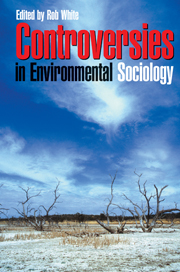Book contents
- Frontmatter
- Contents
- Tables and Figures
- Author Notes
- Abbreviations
- Introduction: Sociology, Society and the Environment
- PART I SOCIAL PERSPECTIVES
- PART II SOCIAL TRENDS
- PART III SOCIAL ISSUES
- 12 Moulding and Manipulating the News
- 13 Agricultural Production and the Ecological Question
- 14 Pathological Environments
- 15 Assessing the Social Consequences of Planned Interventions
- 16 Criminology, Social Regulation and Environmental Harm
- Index
- References
15 - Assessing the Social Consequences of Planned Interventions
Published online by Cambridge University Press: 05 June 2012
- Frontmatter
- Contents
- Tables and Figures
- Author Notes
- Abbreviations
- Introduction: Sociology, Society and the Environment
- PART I SOCIAL PERSPECTIVES
- PART II SOCIAL TRENDS
- PART III SOCIAL ISSUES
- 12 Moulding and Manipulating the News
- 13 Agricultural Production and the Ecological Question
- 14 Pathological Environments
- 15 Assessing the Social Consequences of Planned Interventions
- 16 Criminology, Social Regulation and Environmental Harm
- Index
- References
Summary
Communities experience continual change. Much of that change is deliberate, the result of planned interventions (policies, plans, programs or projects) that have been initiated and/or implemented by government, at local, state and national levels, by the private sector, or by community groups. While planned interventions are undertaken to achieve desired objectives, there are always unplanned adverse impacts on the environment and on people. In order to consider the appropriateness of a specific intervention, such as whether regulatory approval should be given for a project, and/or what conditions should be imposed, assessment of the likely consequences, both positive and negative, is required.
Projects have many obvious negative consequences on people who live near the site. They also have less obvious impacts that only emerge over time or with careful analysis. Policies, plans and programs also have adverse impacts. Consideration of impacts in the design phase can lead to a reduction in the adverse consequences and to an increase in the benefits of the planned intervention. Planning should be a dynamic process that uses adaptive management principles to iteratively consider the outcomes (positive and negative) of the intervention.
Social Impact Assessment (SIA) is the process of ‘analysing, monitoring and managing the social consequences of development’ (IAIA 2003: 1). SIA, in its ideal form at least, is a powerful approach that can lead to many benefits. Communities benefit by having more say in decisions; they become revitalised through participation; social capital is built; harmful impacts are avoided; and benefits for communities are maximised.
- Type
- Chapter
- Information
- Controversies in Environmental Sociology , pp. 257 - 274Publisher: Cambridge University PressPrint publication year: 2004
References
- 1
- Cited by



